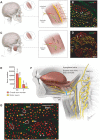Axonal mapping of the motor cranial nerves
- PMID: 37332322
- PMCID: PMC10272770
- DOI: 10.3389/fnana.2023.1198042
Axonal mapping of the motor cranial nerves
Abstract
Basic behaviors, such as swallowing, speech, and emotional expressions are the result of a highly coordinated interplay between multiple muscles of the head. Control mechanisms of such highly tuned movements remain poorly understood. Here, we investigated the neural components responsible for motor control of the facial, masticatory, and tongue muscles in humans using specific molecular markers (ChAT, MBP, NF, TH). Our findings showed that a higher number of motor axonal population is responsible for facial expressions and tongue movements, compared to muscles in the upper extremity. Sensory axons appear to be responsible for neural feedback from cutaneous mechanoreceptors to control the movement of facial muscles and the tongue. The newly discovered sympathetic axonal population in the facial nerve is hypothesized to be responsible for involuntary control of the muscle tone. These findings shed light on the pivotal role of high efferent input and rich somatosensory feedback in neuromuscular control of finely adjusted cranial systems.
Keywords: facial muscles; facial nerve; hypoglossal nerve; masseteric nerve; motor control; proprioception; sensory feedback; sympathetic axons.
Copyright © 2023 Tereshenko, Maierhofer, Dotzauer, Laengle, Politikou, Carrero Rojas, Festin, Luft, Jaklin, Hruby, Gohritz, Farina, Blumer, Bergmeister and Aszmann.
Conflict of interest statement
The authors declare that the research was conducted in the absence of any commercial or financial relationships that could be construed as a potential conflict of interest.
Figures





Similar articles
-
Peripheral cranio-spinal nerve communication for trapezius muscle control using axonal profiling through immunostaining.Sci Rep. 2024 Oct 25;14(1):25266. doi: 10.1038/s41598-024-76645-x. Sci Rep. 2024. PMID: 39448752 Free PMC article.
-
Newly identified axon types of the facial nerve unveil supplemental neural pathways in the innervation of the face.J Adv Res. 2023 Feb;44:135-147. doi: 10.1016/j.jare.2022.04.009. Epub 2022 Apr 22. J Adv Res. 2023. PMID: 36725185 Free PMC article.
-
Neural circuits underlying tongue movements for the prey-catching behavior in frog: distribution of primary afferent terminals on motoneurons supplying the tongue.Brain Struct Funct. 2016 Apr;221(3):1533-53. doi: 10.1007/s00429-014-0988-1. Epub 2015 Jan 10. Brain Struct Funct. 2016. PMID: 25575900
-
Control of tongue and facial motility: neural mechanisms that may contribute to movements such as swallowing and sucking.Symp Oral Sens Percept. 1973;(4):222-31. Symp Oral Sens Percept. 1973. PMID: 4612817 Review. No abstract available.
-
On the Cranial Nerves.NeuroSci. 2023 Dec 28;5(1):8-38. doi: 10.3390/neurosci5010002. eCollection 2024 Mar. NeuroSci. 2023. PMID: 39483811 Free PMC article. Review.
Cited by
-
Emotional contagion to vocal smile revealed by combined pupil reactivity and motor resonance.Sci Rep. 2024 Oct 23;14(1):25043. doi: 10.1038/s41598-024-74848-w. Sci Rep. 2024. PMID: 39443497 Free PMC article.
-
Peripheral cranio-spinal nerve communication for trapezius muscle control using axonal profiling through immunostaining.Sci Rep. 2024 Oct 25;14(1):25266. doi: 10.1038/s41598-024-76645-x. Sci Rep. 2024. PMID: 39448752 Free PMC article.
-
Electrical stimulation of smiling muscles reduces visual processing load and enhances happiness perception in neutral faces.Commun Psychol. 2025 Jul 2;3(1):94. doi: 10.1038/s44271-025-00281-y. Commun Psychol. 2025. PMID: 40604136 Free PMC article.
References
-
- Angelov D. N. (2016). Embryology and anatomy of the facial nerve: Correlates of misdirected reinnervation and poor recovery of function after lesions. Facial Nerve Disord. Dis. Diag. Manage. 1, 8–10. 10.1055/b-0036-140477 - DOI
-
- Baumel J. (1974). Trigeminal-facial nerve communcations. Arch. Otolaryngol. 99 34–44. - PubMed
-
- Borschel G. H., Kawamura D. H., Kasukurthi R., Hunter D. A., Zuker R. M., Woo A. S. (2012). The motor nerve to the masseter muscle: An anatomic and histomorphometric study to facilitate its use in facial reanimation. J. Plastic Reconstruc. Aesthetic Surg. 65 363–366. 10.1016/j.bjps.2011.09.026 - DOI - PubMed
LinkOut - more resources
Full Text Sources
Miscellaneous

